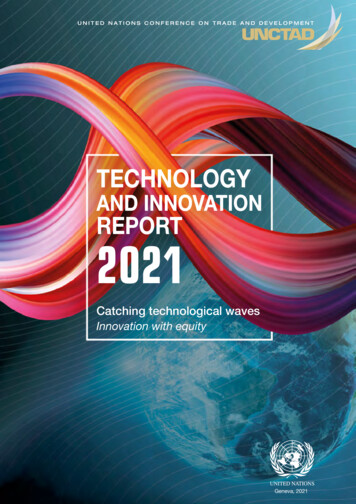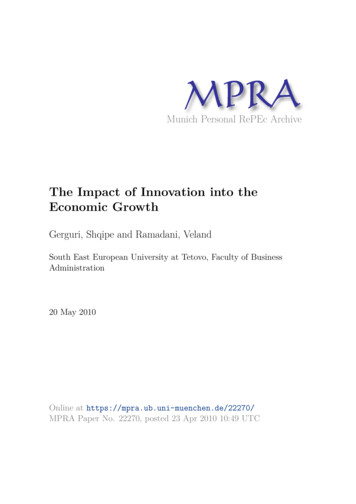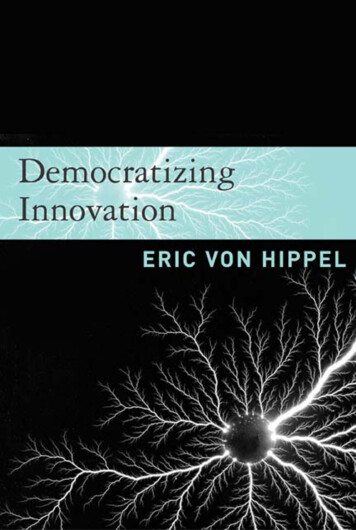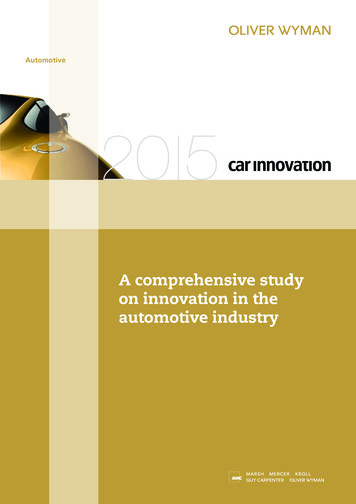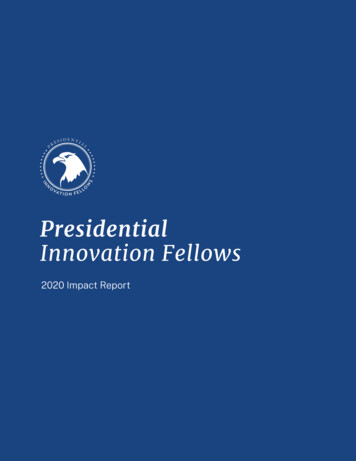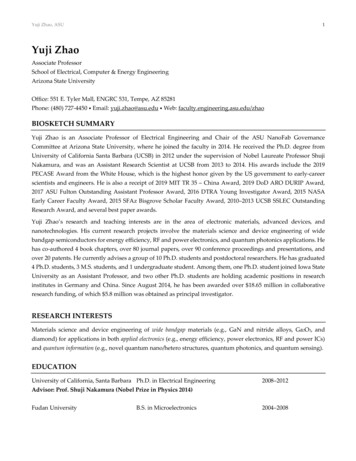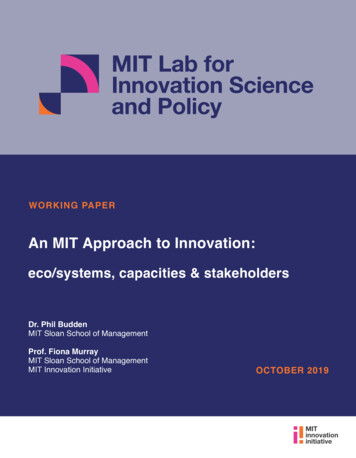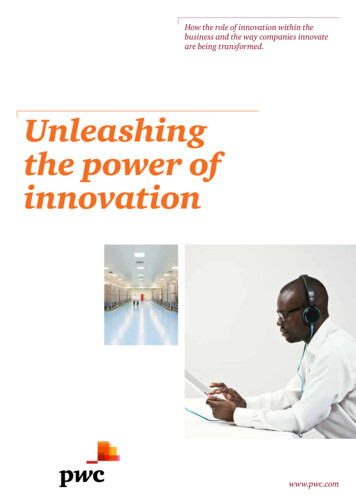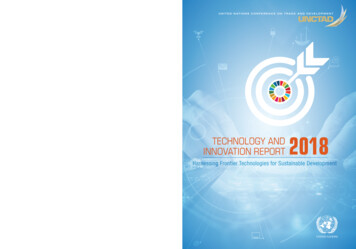
Transcription
UNCTADU N I T E D N AT I O N S C O N F E R E N C E O N T R A D E A N D D E V E L O P M E N TTECHNOLOGY AND INNOVATION REPORT 2018TECHNOLOGY ANDINNOVATION REPORT2018Harnessing Frontier Technologies for Sustainable DevelopmentUNITED NATIONS
U N I T E D N AT I O N S C O N F E R E N C E O N T R A D E A N D D E V E L O P M E N TTECHNOLOGY ANDINNOVATION REPORTHarnessing Frontiier Technologgies for Sustainable DevelopmentNew York and Geneva, 2018
HARNESSING FRONTIER TECHNOLOGIES FOR SUSTAINABLE DEVELOPMENT 2018, United NationsThe work is available open access by complying with the Creative Commons license created for intergovernmentalorganizations, available at e designation employed and the presentation of material on any map in this work do not imply the expressionof any opinion whatsoever on the part of the United Nations concerning the legal status of any country, territory,city or area or of its authorities, or concerning the delimitation of its frontiers or boundaries.Photocopies and reproductions of excerpts are allowed with proper credits.The publication has been edited externally.United Nations publication issued by the United Nations Conference on Trade and Development.UNITED NATIONS PUBLICATIONUNCTAD/TIR/2018Sales No. E.18.II.D.3ISSN 2076-2917ISBN 978-92-1-112925-0e-ISBN 978-92-1-363310-6Copyright United Nations, 2018All rights reserved. Printed in Switzerlandii TECHNOLOGY AND INNOVATION REPORT 2018
FOREWORDFOREWORDWe live at a time of technological change that is unprecedented in its pace, scope and depth of impact. Harnessingthat progress is the surest path for the international community to deliver on the 2030 agenda for people,peace and prosperity. Frontier technologies hold the promise to revive productivity and make plentiful resourcesavailable to end poverty for good, enable more sustainable patterns of growth and mitigate or even reversedecades of environmental degradation. But technological change and innovation need to be directed towardsinclusive and sustainable outcomes through a purposeful effort by governments, in collaboration with civil society,business and academia. If policy-makers are not proactive technological disruption can entrench inequality,further marginalize the poorest, and fuel reactionary movements against open societies and economies.The Technology and Innovation Report 2018: Harnessing Frontier Technologies for Sustainable Developmentnotes that change is becoming exponential thanks to the power of digital platforms and innovative combinationsof different technologies that become possible every day. This opens exciting possibilities for the democratizationof frontier technologies to materialize in development solutions. The Report proposes strategies and actions,some of them based on existing experiences in STI policy for development, and some more innovative ones tomake technology an effective means of implementation of our common development agenda – nationally andglobally.The Report also suggests that countries develop policies to help people navigate the transition period that liesahead. This may require that stakeholders adapt the social contract to the new world that frontier technologiesare forming. Education will become an even more indispensable lever for development and social justice. Sincedigital technologies as enablers and multipliers of other frontier technologies we should ensure that all – andspecially women and girls – are given a real chance to build digital capabilities. Lifelong learning will need to besupported. For those who may struggle to keep up with the transformation, countries will have to be innovativein providing effective social protection mechanisms.Most crucially, there is an urgent need for a sustained effort by the international community to ensure thatthe multiple gaps in technological capabilities that separate developed and developing countries are closed.Investment in hard and soft infrastructure and human capital, complemented by a scaled up, coherent andaccelerated effort to enhance innovation systems for sustainable development are necessary to spread theHFRQRPLF VRFLDO DQG HQYLURQPHQWDO EHQHƄWV RI IURQWLHU WHFKQRORJLHV By providing a platform for policy dialogue and experience-sharing, and through our capacity-buildingprogrammes, UNCTAD and the UN Commission for Science and Technology for Development, which we service,KDYH DQ LQWHUQDWLRQDO SROLF\ UROH WR IXOƄO LQ WKH GHYHORSPHQW RI WKH JOREDO UHVSRQVH WR WKRVH FKDOOHQJHV 2XU intention is that the Technology and Innovation Report 2018 will help launch a dialogue about how to harnesstechnology for the achievement of the SDGs and in larger and more profound sense, the shared future of thepeople of the world.Mukhisa KituyiSecretary-General of UNCTADiii
HARNESSING FRONTIER TECHNOLOGIES FOR SUSTAINABLE DEVELOPMENTACKNOWLEDGEMENTSThe Technology and Innovation Report 2018 was written by an UNCTAD team led by Shamika N. Sirimanne,Director of the Division on Technology and Logistics. The team members included Bob Bell, Pilar Fajarnés, Angel*RQ]¾OH] 6DQ] 0LFKDHO /LP 7DQVXč 2N EL\ 6RORPRQ DQG %ODQFKH 7LQJ Major substantive inputs were provided by Shashi Buluswar (Institute for Transformative Technologies),Dominique Foray (École Polytechnique Fédérale de Lausanne), Banning Garrett (Singularity University) and&DUROLQH :DJQHU 2KLR 6WDWH 8QLYHUVLW\ GGLWLRQDO LQSXWV ZHUH SURYLGHG E\ 0LFKDO 0LHG]LQVNL 8QLYHUVLW\ &ROOHJH London) and Alfred Watkins (Global Solutions Summit). Visualization contributions by Elsevier based on Scopusdata, particularly those of Jeroen Baas (Head of Data Science, Research Intelligence, Elsevier), are gratefullyacknowledged.Comments and suggestions provided at an internal peer review meeting by the following UNCTAD staff are alsogratefully acknowledged: Rashmi Banga, Marisa Henderson, Kalman Kalotay, Dong Wu and Anida Yupari. Usefulwritten comments were also given by Jan Hoffmann.2EVHUYDWLRQV DQG VXJJHVWLRQV IURP WKH IROORZLQJ H[WHUQDO UHYLHZHUV KHOSHG WR LPSURYH WKH GUDIW RI WKH UHSRUW DQG DUH JUDWHIXOO\ DFNQRZOHGJHG }/XGRYLFR OFRUWD 818 0(5,7 3DWULHV %RHNKROW ,QQRYDWLRQ 3ROLF\ 0DWWHUV Cristina Chaminade (Lund University), Neth Daño (Action Group on Erosion, Technology and Concentration),;LDRODQ )X 8QLYHUVLW\ RI 2[IRUG DQG -RKDQ 6FKRW 8QLYHUVLW\ RI 6XVVH[ 7KH VWDWHPHQWV PDGH LQ WKH UHSRUW KRZHYHU DUH WKH H[FOXVLYH UHVSRQVLELOLW\ RI WKH 81&7 ' VHFUHWDULDW } The manuscript was edited by David Woodward and Michael Gibson. Magali Studer was responsible for thecover design. Nathalie Loriot was responsible for the layout. Administrative support was provided by MalouPasinos.iv TECHNOLOGY AND INNOVATION REPORT 2018
ABBREVIATIONSABBREVIATIONSASEANAssociation of Southeast Asian NationsBDABig Data Analysis Initiative (Malaysia)CERN(XURSHDQ 2UJDQL]DWLRQ IRU 1XFOHDU 5HVHDUFKCRISPRclustered regularly interspaced short palindromic repeatsFDIforeign direct investmentGDPgross domestic productGIFGlobal Innovation FundGPSglobal positioning systemHAPShigh-altitude platform stationICTinformation and communication technologyIDCInternational Data CorporationILO,QWHUQDWLRQDO /DERXU 2UJDQL]DWLRQIoTInternet of ThingsIPintellectual propertyIPRintellectual property rightkWhkilowatt-hourLDCleast developed countryM&Emonitoring and evaluationMOOCmassive open online courseOECD2UJDQL]DWLRQ IRU (FRQRPLF &RRSHUDWLRQ DQG 'HYHORSPHQWPEDplatform for economic discoveryPVphotovoltaicR&Dresearch and developmentS3smart specialization strategySMEsmall and medium-sized enterpriseSTEMscience, technology, engineering and mathematicsSTIscience, technology and innovationTRIPStrade-related intellectual property rightsTRIPS Agreement JUHHPHQW RQ 7UDGH 5HODWHG ,QWHOOHFWXDO 3URSHUW\ 5LJKWV :72TVETtechnical and vocational education and trainingUBIuniversal basic incomeUIS81(6&2 ,QVWLWXWH IRU 6WDWLVWLFVUNDPUnited Nations Development ProgrammeUNIDO8QLWHG 1DWLRQV ,QGXVWULDO 'HYHORSPHQW 2UJDQL]DWLRQUNESCO8QLWHG 1DWLRQV (GXFDWLRQDO 6FLHQWLƄF DQG &XOWXUDO 2UJDQL]DWLRQWEFWorld Economic ForumWFPUnited Nations World Food ProgrammeWTO:RUOG 7UDGH 2UJDQL]DWLRQv
HARNESSING FRONTIER TECHNOLOGIES FOR SUSTAINABLE DEVELOPMENTCONTENTSFOREWORD . iiiACKNOWLEDGEMENTS . ivABBREVIATIONS . vOVERVIEW . xiCHAPTER IFRONTIER TECHNOLOGIES AND SUSTAINABLE DEVELOPMENT .1A.INTRODUCTION . 2B.FRONTIER TECHNOLOGIES: UNPRECEDENTED POSSIBILITIES, INTRACTABLECHALLENGES . 3C.DISTINGUISHING FEATURES OF FRONTIER TECHNOLOGIES . 41. Technologies building on each other . 42. Moore’s Law . 43. Technology convergence . 64. Declining costs . 65. Multiple platforms . 66. Reduced entry costs . 7D.KEY TECHNOLOGIES AND THEIR POTENTIAL CONTRIBUTIONS TO SUSTAINABLEDEVELOPMENT . 7 %LJ GDWD WKH ,QWHUQHW RI 7KLQJV DQG DUWLƄFLDO LQWHOOLJHQFH . 72. 3D printing . 133. Biotechnology and health tech . 164. Advanced materials and nanotechnology . 175. Renewable energy technologies. 186. Satellites and drones. 207. Blockchain . 20E.KEY CONSIDERATIONS FOR HARNESSING FRONTIER TECHNOLOGIES FORSUSTAINABLE DEVELOPMENT . 21 UWLƄFLDO LQWHOOLJHQFH FRXOG FUHDWH t DQG GHVWUR\ t MREV . 212. Frontier technologies present challenges for privacy, security and algorithmic transparency . 263. Frontier technologies have an unclear relationship to productivity growth and otherdevelopment indicators . 26F.CONCLUSIONS . 27REFERENCES . 30vi TECHNOLOGY AND INNOVATION REPORT 2018
CONTENTSCHAPTER IIBENEFITING FROM FRONTIER TECHNOLOGIES: GAPS ANDCAPABILITIES .37A.INTRODUCTION . 38B.THE INTERNATIONAL DIVIDE IN RESEARCH AND DEVELOPMENT CAPABILITIES. 38C.BUILDING SKILLS FOR COMPLEMENTARITY WITH NEW TECHNOLOGIES ISCRITICAL . 42D. TECHNOLOGICAL AND DIGITAL GENDER DIVIDES . 441. Women in science and technology. 442. Gender divides in manufacturing employment, including ICTs . 453. The gender gap in mobile ownership and Internet use . 46E. THE ENERGY GAP AND THE DIGITAL DIVIDE . 47F.CONCLUSIONS . 48REFERENCES . 50CHAPTER III FOUNDATIONS OF STI POLICY FOR SUSTAINABLE AND INCLUSIVEDEVELOPMENT .53A.INNOVATION SYSTEMS: BUILDING AN ENABLING ENVIRONMENT FOR STI. 541. Capabilities of actors in the innovation system . 542. Connections in the innovation system . 553. The innovation system as an enabling environment . 554. Financing innovation . 575. Patent protection and incentives for innovation and investment. 60B.POLICY COHERENCE: INTEGRATING STI POLICIES IN DEVELOPMENT STRATEGIES .621. Aligning STI policy with national development plans . 622. Steps towards building synergies between STI policy and national development plans . 64C.REDIRECTING INNOVATION TOWARDS INCLUSIVENESS AND SUSTAINABILITY . 661. STI policies for inclusiveness and sustainability . 662. Intellectual property rights and the Sustainable Development Goals . 683. Technological change, employment and the social contract: Is this time different? . 71D.CONCLUSIONS . 75REFERENCES . 77vii
HARNESSING FRONTIER TECHNOLOGIES FOR SUSTAINABLE DEVELOPMENTCHAPTER IV FRONTIER TECHNOLOGIES, EMERGING APPROACHES ANDOPPORTUNITIES .83A.LEAPFROGGING: LOOK BEFORE YOU LEAP? . 84B.EXTENDING BENEFICIARIES: ALTERNATIVE MODESOF INNOVATION . 86C.SMART SPECIALIZATION: INNOVATION AS A STRATEGY FOR COMPETITIVEADVANTAGE . 891. The S3 approach . 892. S3 as a vertical policy approach. 893. Establishing priorities . 904. Developing transformative activities. 905. S3 as experimental policy . 916. Experience with S3 to date . 917. Further development possibilities . 92D.PLATFORMS FOR ECONOMIC DISCOVERY . 921. Technology, innovation and economic discovery . 922. Platforms for economic discovery as a tool for innovation and cooperation policy . 933. Designing platforms for economic discovery to achieve key innovation objectives . 944. Platforms for economic discovery as an opportunity for international cooperation . 94E.INNOVATIVE FINANCING . 951. Venture capital and business angels . 952. Impact investment . 963. Crowdfunding . 974. Innovation and technology funds . 985. New types of bonds. 99F.INCUBATORS, ACCELERATORS AND TECHNOLOGY PARKS . 100G.SHAPING INTERNATIONAL COLLABORATIVE RESEARCH NETWORKS TOSERVICE THE SUSTAINABLE DEVELOPMENT GOALS . 1011. The growth of global research collaboration . 1012. Drivers of global collaboration . 1033. Implications of global collaboration for STI governance and policy . 1044. Fostering participation in global research collaboration towardsthe Sustainable Development Goals. 1055. Maximizing development impact . 106H. CONCLUSIONS . 107REFERENCES . 109viii TECHNOLOGY AND INNOVATION REPORT 2018
CONTENTSBoxesBox 1.1Quantum computing . 5Box 1.2Increasing automation in China . 10Box 1.3Data visualization and interactive mapping to support response to disease outbreak in Uganda . 10Box 1.4Big data to provide insurance for small-scale farmers in Africa. 11Box 1.5Big data for agriculture in India . 11Box 1.6Water quality monitoring using Internet of Things: Bangladesh . 11Box 1.7.Big data for estimating food security in Rwanda . 12Box 1.8Harnessing big data to support development goals . 13Box 1.9National Big Data Analysis Initiative, Malaysia . 13Box 1.10 Examples of 3D printing . 15Box 1.11 Fabrication laboratories as experimental learning spaces for local innovation systems . 16Box 1.12 The potential of synthetic biology (CRISPR-Cas9) . 17Box 1.13 Potential gender implications of digital automation . 22Box 1.14 The great convergence – The changing geography of manufacturing and knowledge . 23Box 1.15 Studies on the impact of automation on employment in developing countries . 25Box 1.16 Key messages and conclusions . 29Box 2.1Technology readiness and innovation . 43Box 2.2Key messages and conclusions . 49%R[ 3ROLF\ OHVVRQV RQ WKH ƄQDQFLQJ RI LQQRYDWLRQ IURP 81&7 ' WHFKQLFDO FRRSHUDWLRQ . 59Box 3.2Key lessons from UNCTAD’s work on STI policies for development . 63Box 3.3Finland’s Research and Innovation Council – Leadership and coordination of keystakeholders in innovation policy design, and well-developed M&E practices . 65%R[ 2ZQHUVKLS GLVSXWH RYHU &5,635 &DV JHQH HGLWLQJ WRRO. 70Box 3.5Finland’s partial basic income experiment, 2017–2018 . 74Box 3.6Key messages and conclusions . 76Box 4.1FinTech . 85Box 4.2Grass-roots innovation: Examples . 87Box 4.3Social innovation: Examples . 88Box 4.4The Yozma programme for venture capital, Israel . 96Box 4.5Impact investment funds aim to create social and environmental impactDV ZHOO DV ƄQDQFLDO UHWXUQ. 97Box 4.6Technology and innovation funds: Peru’s Innovation, Science and Technology Fund . 99Box 4.7Porto Alegre Sustainable Innovation Zone . 100Box 4.8CERN as a model of international cooperation in science . 102Box 4.9What is “open” in global science? . 103Box 4.10 Network operations and incentives. 105Box 4.11 Key messages and conclusions . 108ix
HARNESSING FRONTIER TECHNOLOGIES FOR SUSTAINABLE DEVELOPMENTFiguresFigure 1.1. Technological advances build on previous technological advances . 5Figure 1.2 Growth of big data 2010–2020 . 8Figure 1.3 The use of 3D printing is expected to grow . 14Figure 1.4 Declining costs of solar cells. 19Figure 2.1 Research and development expenditure as a proportion of GDP, by region, 2000–2014(Percentage) . 39Figure 2.2 Researchers (in full-time equivalent) per 1 million inhabitants, by region, 2000–2014 . 40)LJXUH 'LVWULEXWLRQ RI JOREDO ƄUVW XQLYHUVLW\ GHJUHHV LQ 67(0 E\ FRXQWU\ UHJLRQ (Percentage) . 40Figure 2.4 First university degrees in STEM, selected countries, 2000–2012(Thousands) . 41Figure 2.5 Gender gap in mobile ownership in low- and middle-income countries, 2014(Percentage) . 46Figure 2.6 Gender gap in Internet use by level of development and region, 2013 and 2017(Percentage) . 47Figure 2.7 The relationship between Internet use versus electricity access in urban and rural population(Percentage) . 48Figure 3.1 Systemic foundations of innovation and technological upgrading . 56Figure 3.2 Patent applications in selected low- and middle-income countries . 61TablesTable 1.1 Technology clusters discussed in this report as possible contributionsto Sustainable Development Goals . 4Table 1.2. Potential economic impact of Internet of Things in 2025. 9Table 1.3 Major areas for Internet of Things devices in water management . 11Table 2.1 Share of female researchers, by region . 45Table 3.1 Policy instruments to foster innovation for sustainable development . 67Table 4.1 Policy design principles for smart specialization. 92Table 4.2 Sectoral roles in R&D . 104x TECHNOLOGY AND INNOVATION REPORT 2018
OVERVIEWOVERVIEWThe 2030 Agenda for Sustainable Development setsambitious global goals, demanding unprecedentedactions and efforts across multiple interconnectedsocial, economic and environmental issues. Science,technology and innovation (STI) must play a centralrole in the achievement of these goals. The processof creative destruction initiated by technologicalprogress can help to transform economies andimprove living standards, by increasing productivity,reducing production costs and prices, and helping toraise real wages.Harnessing frontier technologies – combined withaction to address persistent gaps among developedand developing countries in access and use of existingtechnologies, and to develop innovations (includingnon-technological and new forms of social innovation)– could be transformative in achieving the SustainableDevelopment Goals and producing more prosperous,sustainable, healthy and inclusive societies. Theyoffer the prospect of solutions and opportunities forsustainable development that are better, cheaper,faster, scalable and easy to use. The extent of thedevelopmental impact of technological advanceshas already been seen in the transformative effectsof information and communication technologies(ICTs) in many low-income economies, while thepotential to increase the environmental sustainabilityof development is evident in recent advances inrenewable energy. However, new technologiesthreaten to outpace the ability of societies andpolicymakers to adapt to the changes they create,giving rise to widespread anxiety and ambivalence orhostility to some technological advances.I.FEATURES AND POTENTIAL OFFRONTIER TECHNOLOGIESThe dramatically accelerating pace of developmentand adoption of new technologies in recent decadesis likely to continue, driven by (a) the cumulative natureof technological change; (b) the expon
iv TECHNOLOGY AND INNOVATION REPORT 2018 HARNESSING FRONTIER TECHNOLOGIES FOR SUSTAINABLE DEVELOPMENT ACKNOWLEDGEMENTS The Technology and Innovation Report 2018 was written by an UNCTAD team led by Shamika N. Sirimanne, Director of the Division on Technology and Logistics. The team members included Bob Bell, Pilar Fajarnés, Angel


